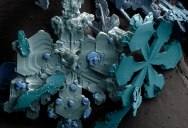25 Microscopic Images of Snow Crystals

At the Beltsville Agricultural Research Center (BARC) in Maryland, you will find the US Department of Agriculture’s Low Temperature Scanning Electron Microscope (LT-SEM). One of the LT-SEM’s uses is for the study of snow crystals. Hydrologists study photographs of the grain sizes, shapes and associations in relation to passive microwave remote sensing in an effort to determine the water content of the winter snow pack. This information is critical to the determination of the nation’s water supply as well as protection from flooding.
Samples of snow, ice and associated life forms are collected by dislodging the crystals or biota from the face of a snow pit or the surface of the snow onto copper metal sample plates containing precooled methyl cellulose solution. Within fractions of a second these plates are plunged into a reservoir of liquid nitrogen which rapidly cools them to -196°C and attaches these pre-frozen materials to the plates. Due to the low surface tension of liquid nitrogen and the extreme hardness of materials cooled to these temperatures, very fragile samples can be shipped by aircraft, in dry shipping dewars from study sites throughout the US.

After arrival at the Beltsville Electron Microscopy facility, the copper plates can be stored at -196°C in storage dewars. Selected samples are transferred to the preparation chamber for sputter coating with platinum. This renders them electrically conductive and they are placed on the pre-cooled (-170°C) stage of a Hitachi S-4100 field emission Scanning Electron Microscope where they are imaged and photographed.
Ordinary Hexagonal Dendrite





Rime and Graupel
Under some atmospheric conditions, forming and descending snow crystals may encounter and pass through atmospheric supercooled cloud droplets. These droplets, which have a diameter of about 10 µm, can exist in the unfrozen state down to temperatures near -40° C. Contact between the snow crystal and the supercooled droplets results in freezing of the liquid droplets onto the surface of the crystals.
This process of crystal growth is know as accretion. Crystals that exhibit frozen droplets on their surfaces are referred to as rimed. When this process continues so that the shape of the original snow crystal is no longer identifiable, the resulting crystal is referred to as graupel. The frozen droplets on the surface of rimed crystals are hard to resolve and the topography of a graupel particle is not easy to record with a light microscope because of the limited resolution and depth of field in the instrument. However, observations of snow crystals with a low temperature LT-SEM clearly show cloud droplets measuring up to 50 µm on the surface of the crystals. [Source]



Examples of LT-SEM magnification capability
Most samples of snow crystals are observed by researchers at relatively moderate magnifications (30X-500X), however the capabilities of the electron microscope allow observation of fine structures at over 100,000X. The following set of photographs demonstrates a magnification series using a low temperature scanning electron microscope (LT-SEM) covering this range. By contrast, the light microscope is only capable of viewing meaningful details at magnifications of about 1,000X and is very limited in depth of field.
Snow samples are very fragile and exposure to the light necessary to photograph them, using light microscopes, can change structures and even melt them. Using LT-SEM, samples are frozen to temperatures below -170 degrees Centigrade where they can be placed in a vacuum and observed for many hours with no structural changes. These photographs show the extraordinary symmetry of snow crystals even at high magnification. [Source]




Comparative Images of Snow Crystals
This series of scanning electron micrographs represents newly precipitated and metamorphosed snow crystals. The small circular inserts are the “classical” light microscopic images. Bars are accurate for all magnifications.



Hexagonal Plate with Dendritic Extensions

Wind-Packed Snow from Alaska’s North Slope

Rimed Hexagonal Snow Crystal

Snow Sample from the Illinois River Site

Hexagonal Snow Crystal with Broad Branches

If you enjoyed this post, the Sifter
highly recommends:

Sign up to get our BEST stories of the week straight to your inbox.




